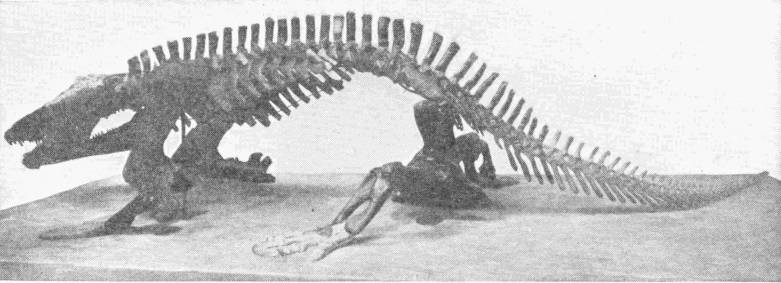




SKULL OF A LABYRINTHODONT, CAPITOSAURUS
Nat. Hist. Mus.
Some of the earlier insects were very large. There were dragon flies in this period with wings that spread out to twenty-nine inches.
In various ways these new orders and genera had adapted themselves to breathing air. Hitherto all animals had breathed air dissolved in water, and that indeed is what all animals still have to do. But now in divers fashions the animal kingdom was acquiring the power of supplying its own moisture where it was needed. A man with a perfectly dry lung would suffocate to-day; {24} his lung surfaces must be moist in order that air may pass through them into his blood. The adaptation to air breathing consists in all cases either in the development of a cover to the old-fashioned gills to stop evaporation, or in the development of tubes or other new breathing organs lying deep inside the body and moistened by a watery secretion. The old gills with which the ancestral fish of the vertebrated line had breathed were inadaptable to breathing upon land, and in the case of this division of the animal kingdom it is the swimming bladder of the fish which becomes a new, deep-seated breathing organ, the lung. The kind of animals known as amphibia, the frogs and newts of to-day, begin their lives in the water and breathe by gills; and subsequently the lung, developing in the same way as the swimming bladder of many fishes do, as a baglike outgrowth from the throat, takes over the business of breathing, the animal comes out on land, and the gills dwindle and the gill slits disappear. (All except an outgrowth of one gill slit, which becomes the passage of the ear and ear-drum.) The animal can now live only in the air, but it must return at least to the edge of the water to lay its eggs and reproduce its kind.
